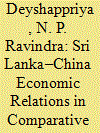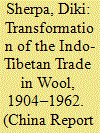|
|
|
Sort Order |
|
|
|
Items / Page
|
|
|
|
|
|
|
| Srl | Item |
| 1 |
ID:
169952


|
|
|
|
|
| Summary/Abstract |
India-China border has not been formally demarcated and there are areas where both sides have differing perception of Line of Actual Control (LAC), and its perception on ground have led to a number of skirmishes and standoffs, Doklam being the most recent. The differentiating factor in this standoff was that it took place in a third country, Bhutan. This crisis will remain an important indicator of Indian and Chinese strategic behaviour in any future crisis between the two emerging powers. This will also reflect on India’s relations with other countries in South Asia and vice versa. A major aspect of Indian strategic behaviour that emerged from this crisis was that India can play the game of military brinkmanship and win it.
|
|
|
|
|
|
|
|
|
|
|
|
|
|
|
|
| 2 |
ID:
169955


|
|
|
|
|
| Summary/Abstract |
This article is a conceptual review of identifying the factors of the successful implementation of Belt and Road Initiative (BRI) on small-medium enterprises (SMEs) in Malaysia. China’s president Xi Jin Ping has launched the China’s ‘One Belt One Road’ (OBOR) initiative or BRI in 2013. BRI focusses on the connectivity and cooperation between Asian, European and African continents economically and strategically through massive infrastructure developments, trades and investments. BRI is specified to two international trade connections: land-based ‘Silk Road Economic Belt’ and sea-based ‘21st Century Maritime Silk Road’. Malaysia is one of the Southeast Asia countries that actively participated in BRI. According to the World Bank, SMEs are almost 98.5 per cent of business establishments in Malaysia, which undoubtedly indicates how important SMEs are in Malaysia. As such, that is the question to ponder of how BRI could connect and associate with the enhancement and development of Malaysia’s SMEs. Therefore, the objective of the study is to identify the factors of the successful implementation of BRI on SMEs in Malaysia. Based on this study’s literature reviews, it would be suggested that new business and investment opportunity creations, connectivity and cooperation enhancement, trade and export boosting, geographic location and enhancement of e-commerce were the most critical factors in the successful implementation of BRI on SMEs in Malaysia.
|
|
|
|
|
|
|
|
|
|
|
|
|
|
|
|
| 3 |
ID:
169953


|
|
|
|
|
| Summary/Abstract |
Summit diplomacy is the initiative to establish contact at the highest level of political leadership to transform the relationship between collectives. The heads of states are key decision makers in the nation. The objective of summit diplomacy is to establish a political dialogue at the highest level. The assumption is that once the understanding is established at the highest level, it can transform a conflicting relationship to friendly one. Rajiv Gandhi’s visit to China in 1988 ended three decades of estrangement between India and China. It is a classic example of the normalisation of relations between two countries. The proposed hypothesis is that the success of Rajiv Gandhi’s summit diplomacy depended on two factors: the leadership personality and the domestic factor. This article primarily deals with the question: How Rajiv Gandhi conducted summit diplomacy with China in 1988? The article traces the process through an analysis of archival work of private papers and diplomatic correspondence, oral history interviews, memoirs, and biographical works.
|
|
|
|
|
|
|
|
|
|
|
|
|
|
|
|
| 4 |
ID:
169956


|
|
|
|
|
| Summary/Abstract |
The article examines recent trends in the economic relations between Sri Lanka and China focussing on trade, investment and tourism dimensions. Although bilateral economic ties between Sri Lanka and China have strengthened over time, the article demonstrates Sri Lanka’s low rank among China’s economic partners. For example, while China is the second-largest tourism partner of Sri Lanka in terms of tourist arrivals, Sri Lanka does not rank among even China’s top 25 tourist destinations.
Consequently, the article recommends certain policy priorities to ensure mutually beneficial economic relations. With regards to tourism, it recommends promoting Sri Lanka’s brand on Chinese e-tourism websites and social media, introducing user-friendly tourist apps in Chinese, strengthening air connectivity and celebrating Chinese festivals. Similarly, trade and investment could be facilitated by stronger links with Chinese cities and connecting Sri Lankan students in China to the Chinese industry via internships and building commercial networks from the ground up.
|
|
|
|
|
|
|
|
|
|
|
|
|
|
|
|
| 5 |
ID:
169957


|
|
|
|
|
| Summary/Abstract |
During the first half of the twentieth century, the wool trade articulated new political and economic relationships between Tibet and the British Raj in India and the world beyond. Kalimpong, the Eastern Himalayan town in North Bengal, flourished on the basis of India’s frontier trade with Tibet for about five decades. By placing the trans-frontier wool trade of colonial India at the centre of analysis, this article seeks to highlight the material history that existed on its landed periphery. An attempt will be made to understand the emergence, pattern and significance of India’s trans-frontier trade with Tibet in the light of major geopolitical changes in this region and the world in the twentieth century. The article will argue that the channelling of trade through the Kalimpong–Lhasa route was driven by multiple colonial interests, as well as commercial considerations. In particular, safeguarding the empire and producing a unified sovereign space in the newly established Himalayan frontier constituted a major concern of the British Raj.
|
|
|
|
|
|
|
|
|
|
|
|
|
|
|
|
|
|
|
|
|